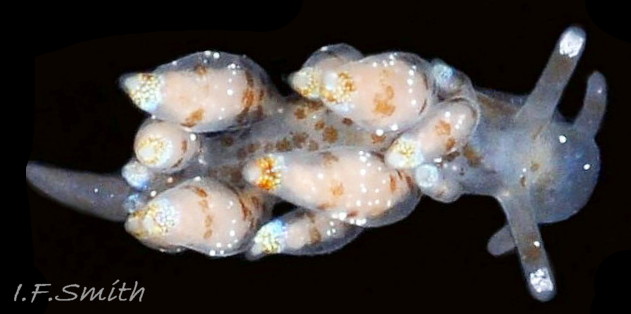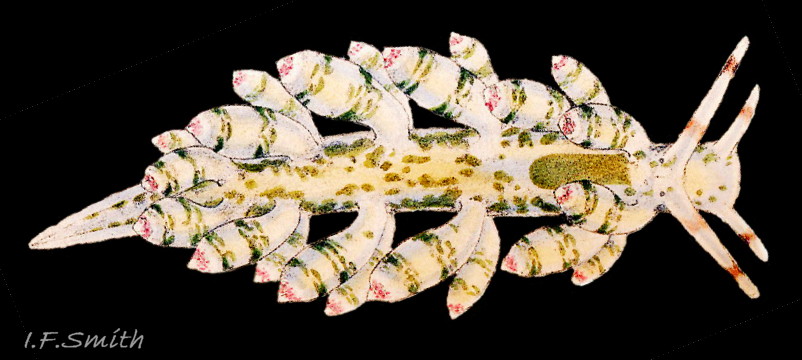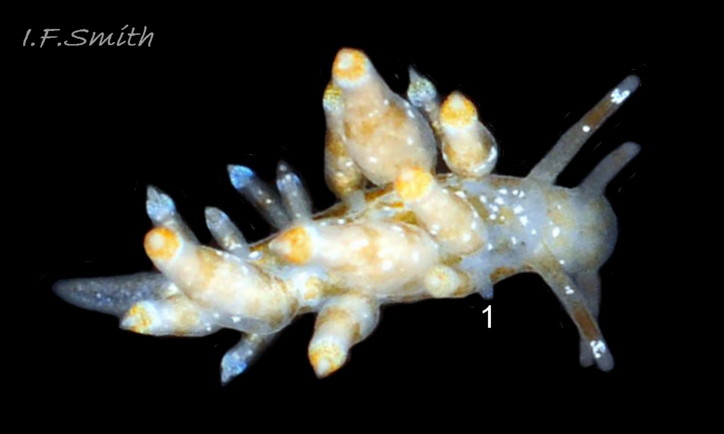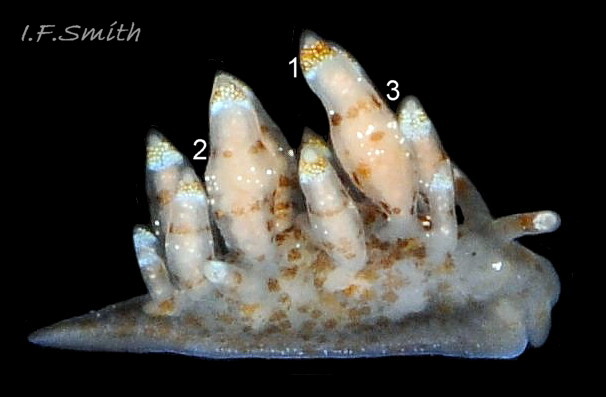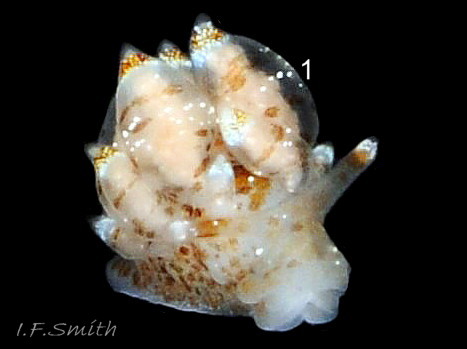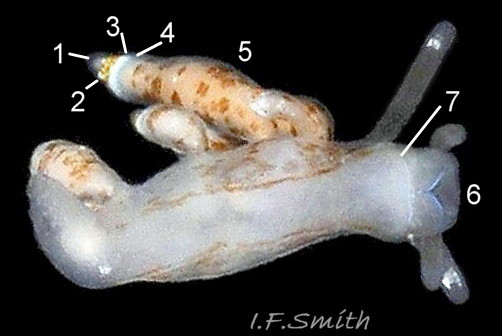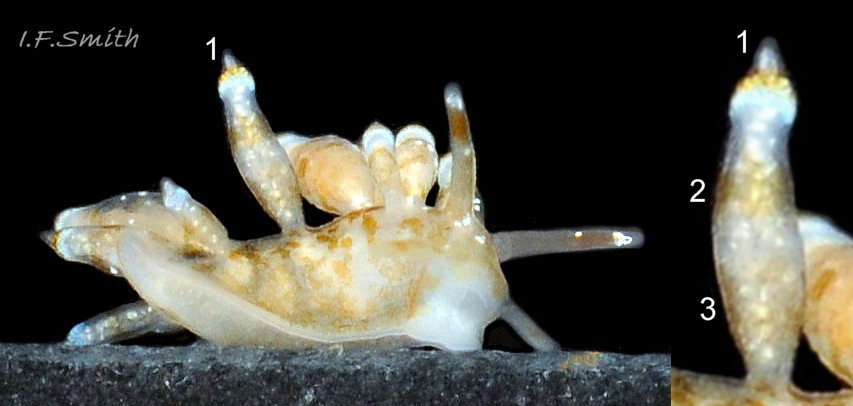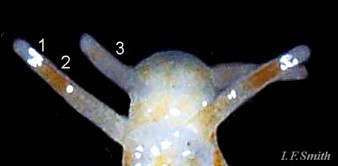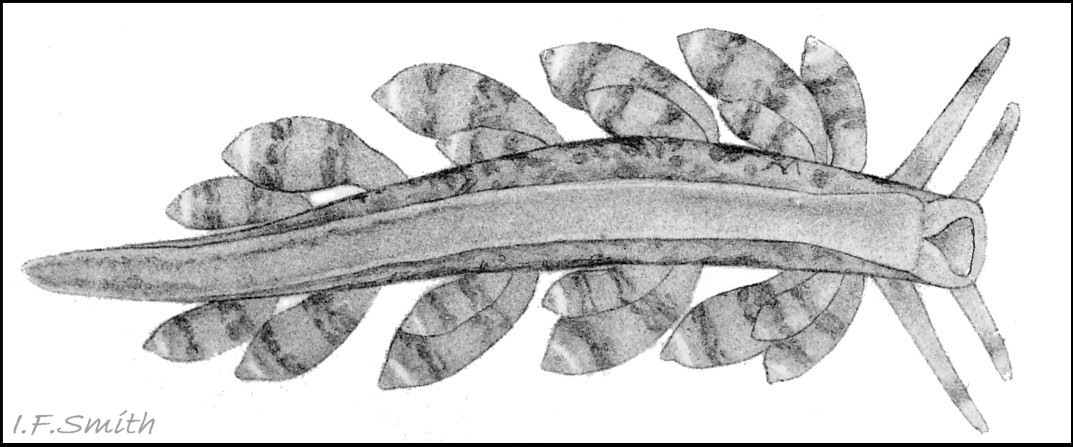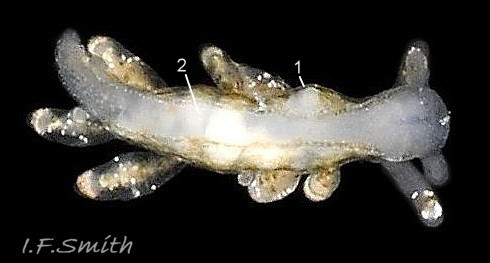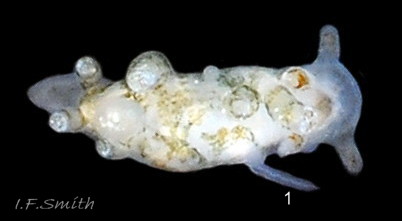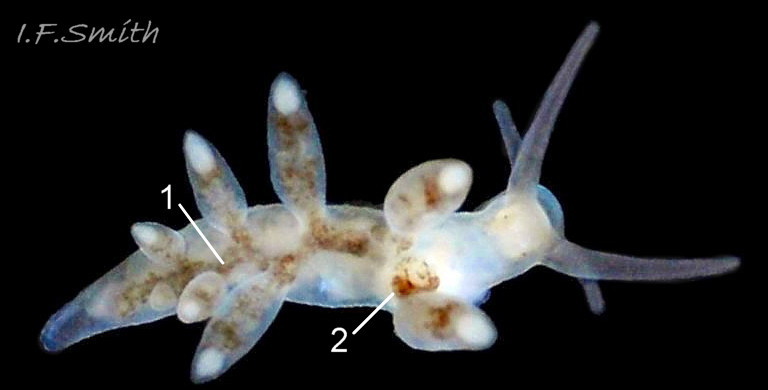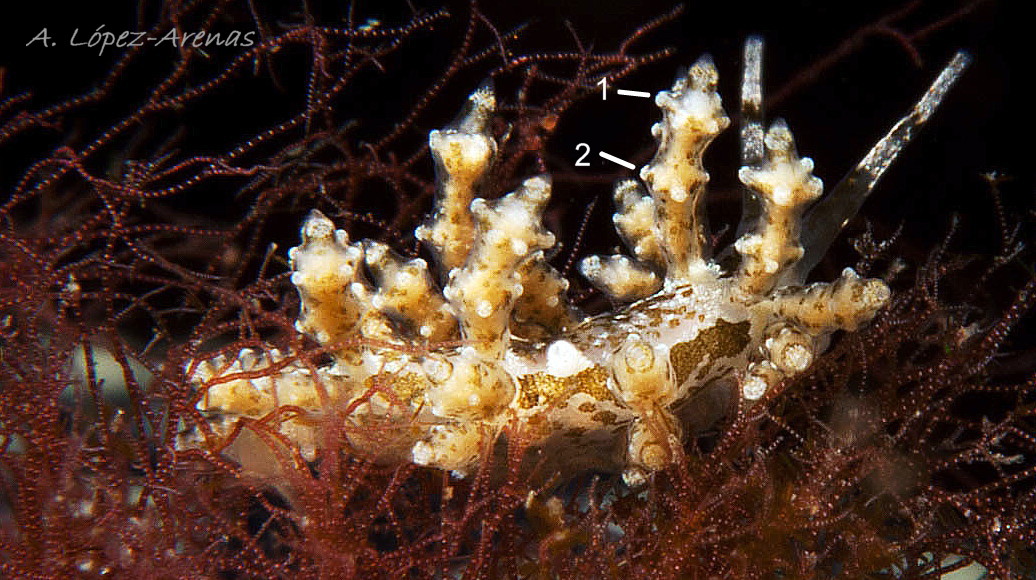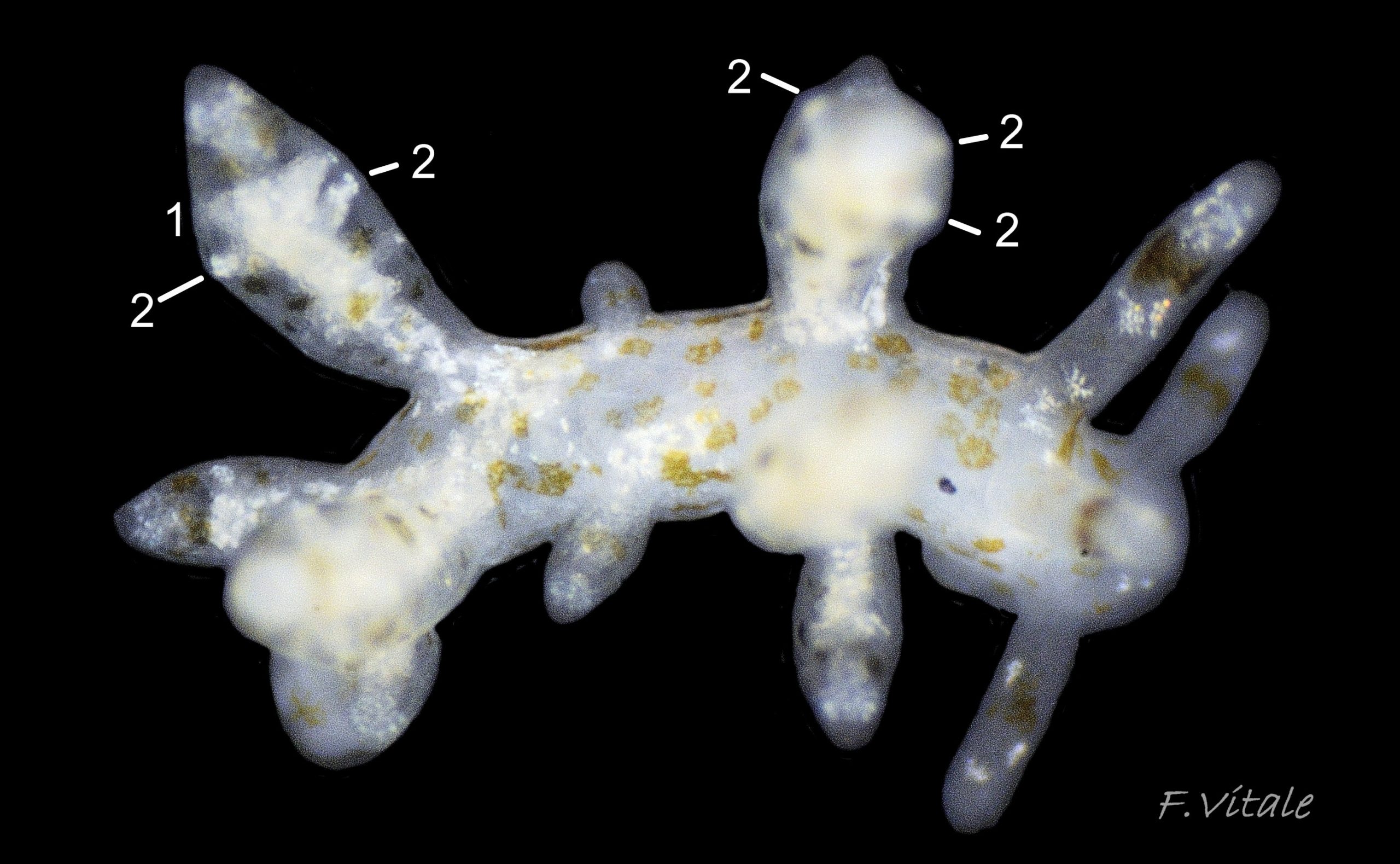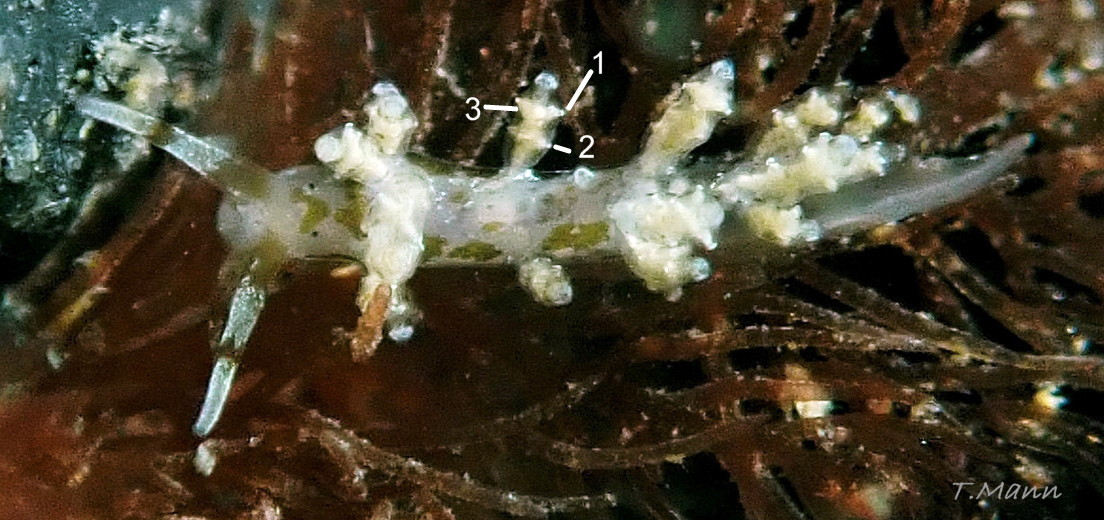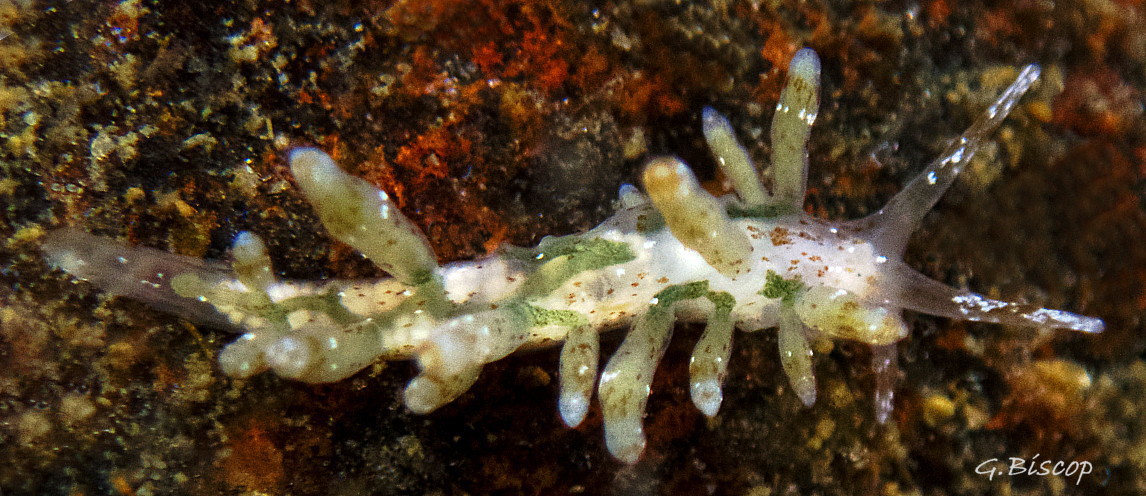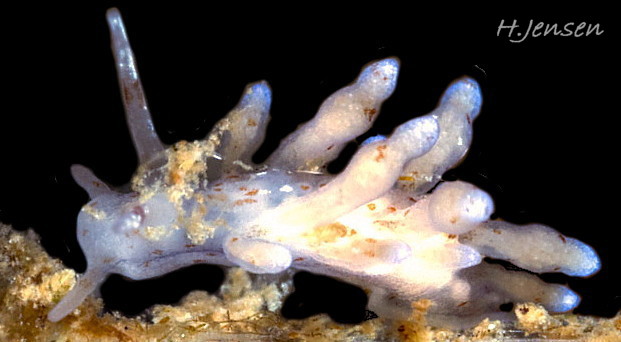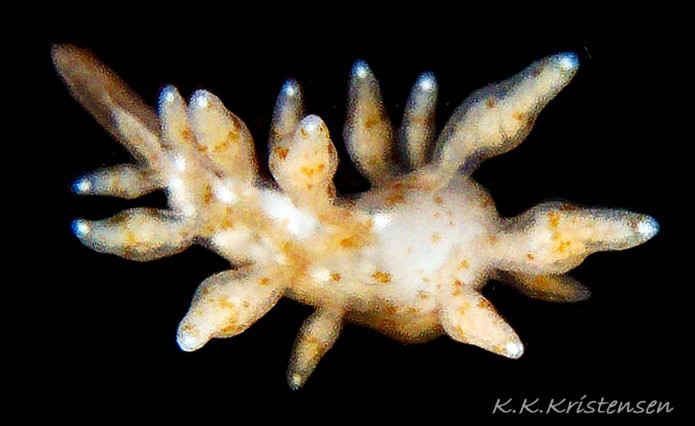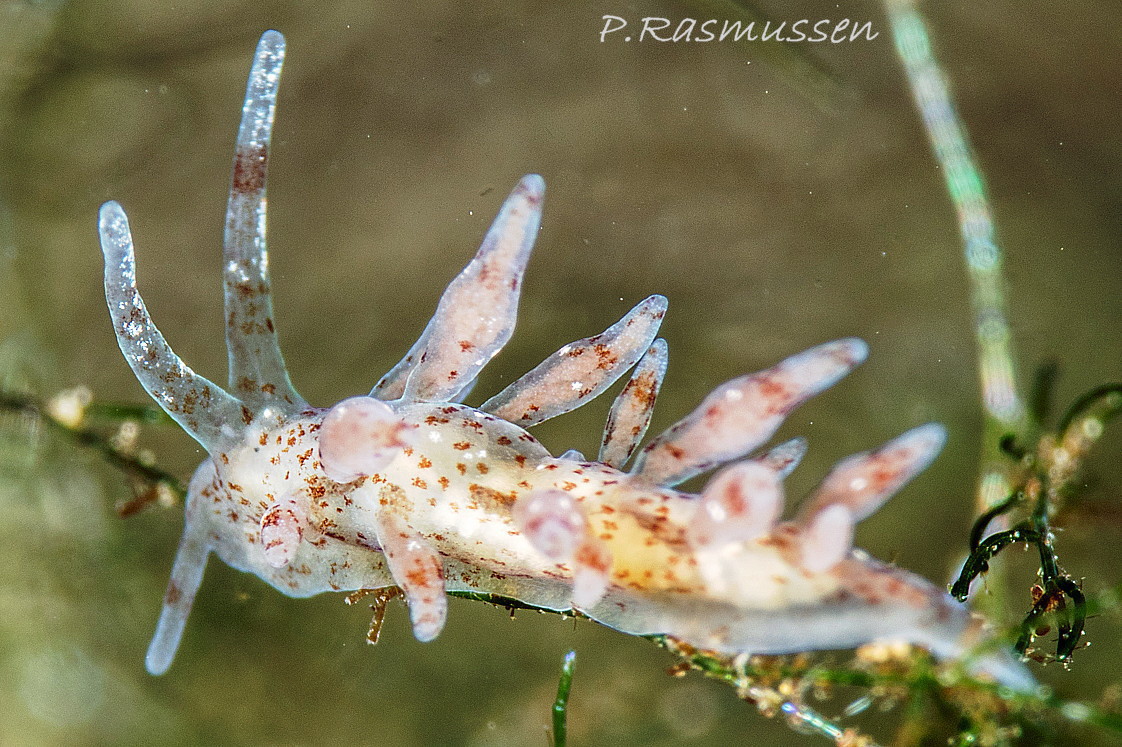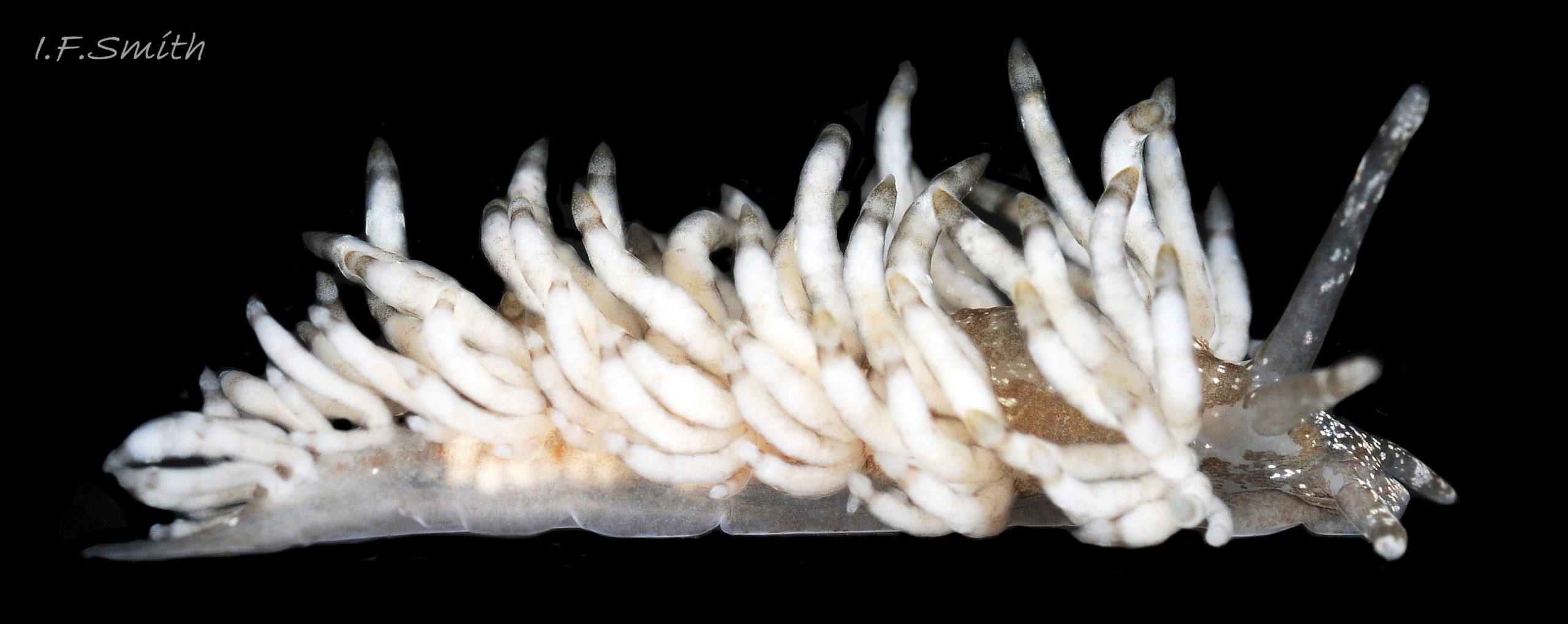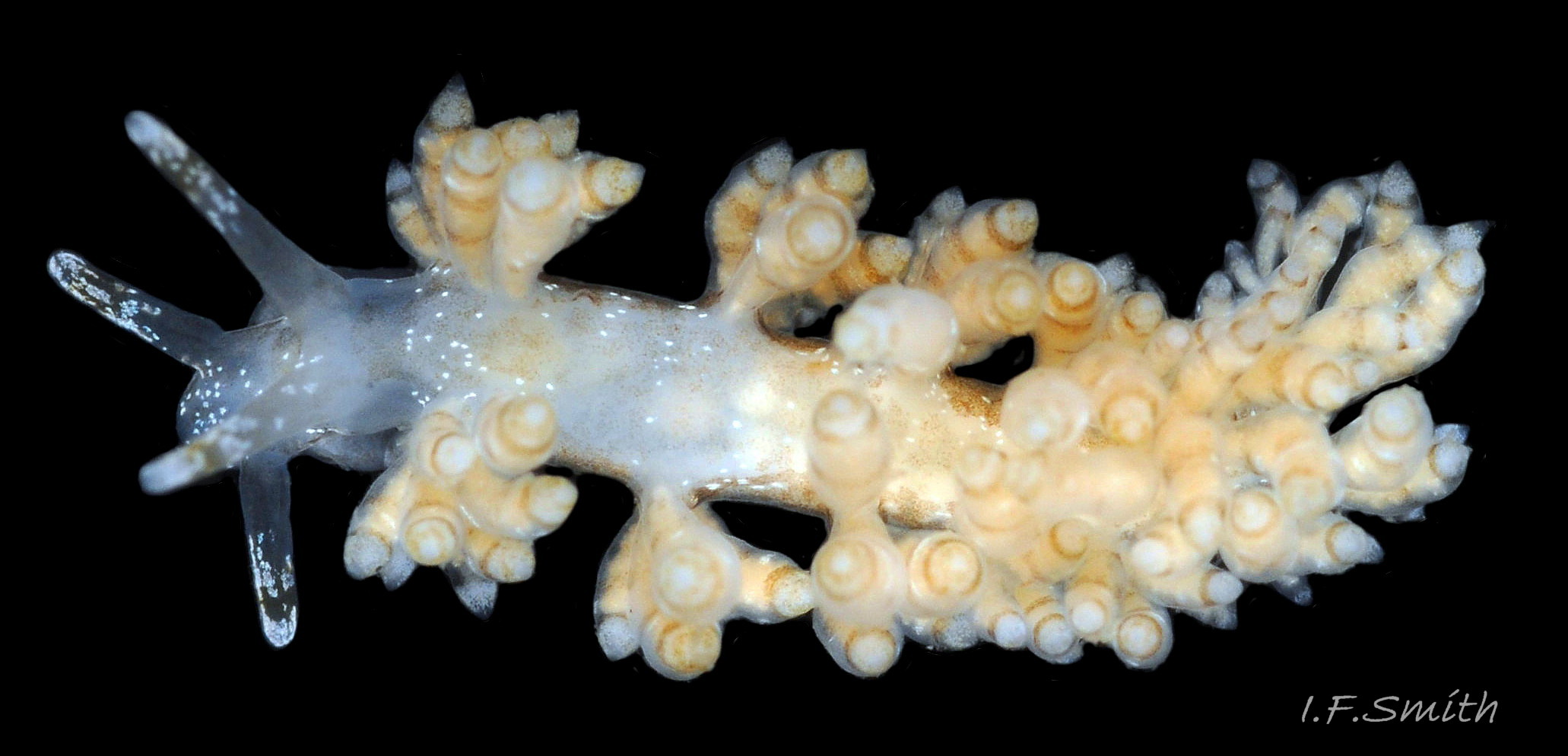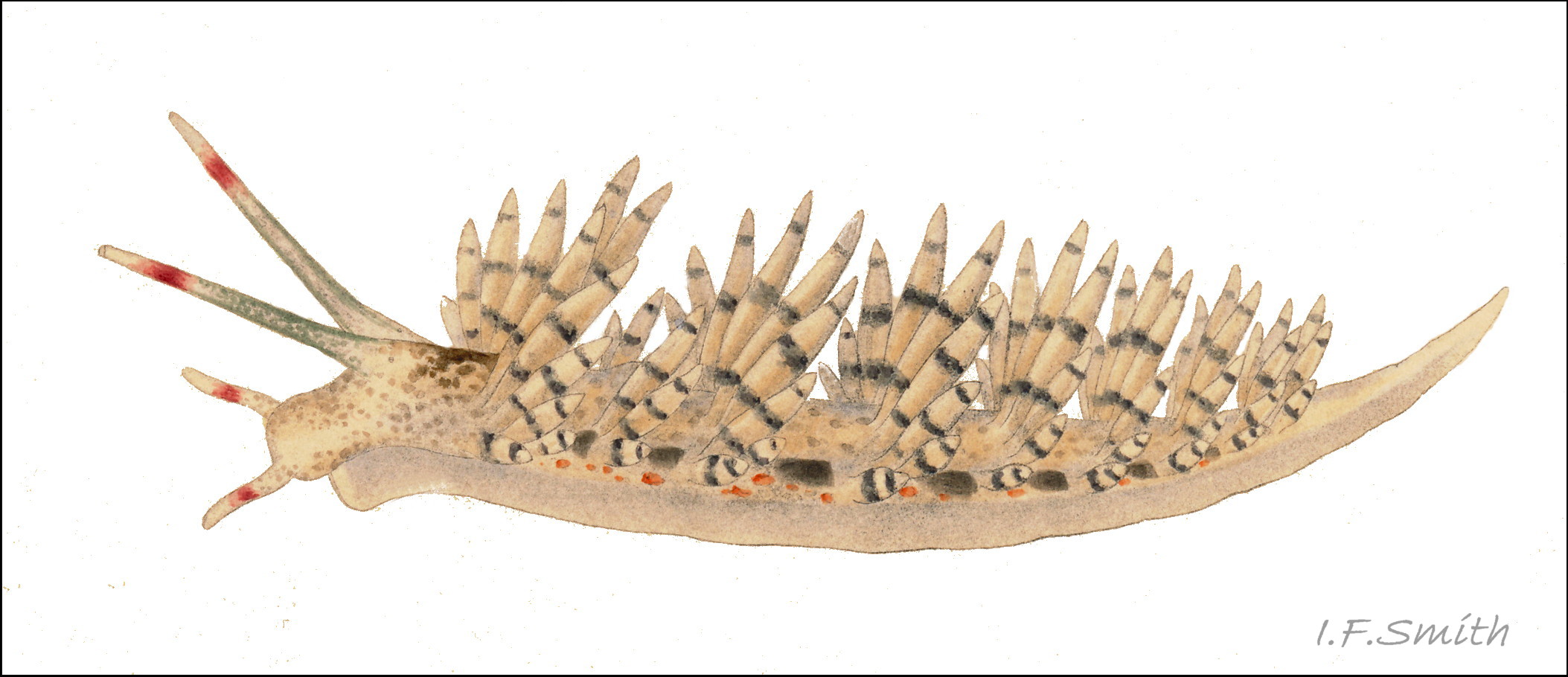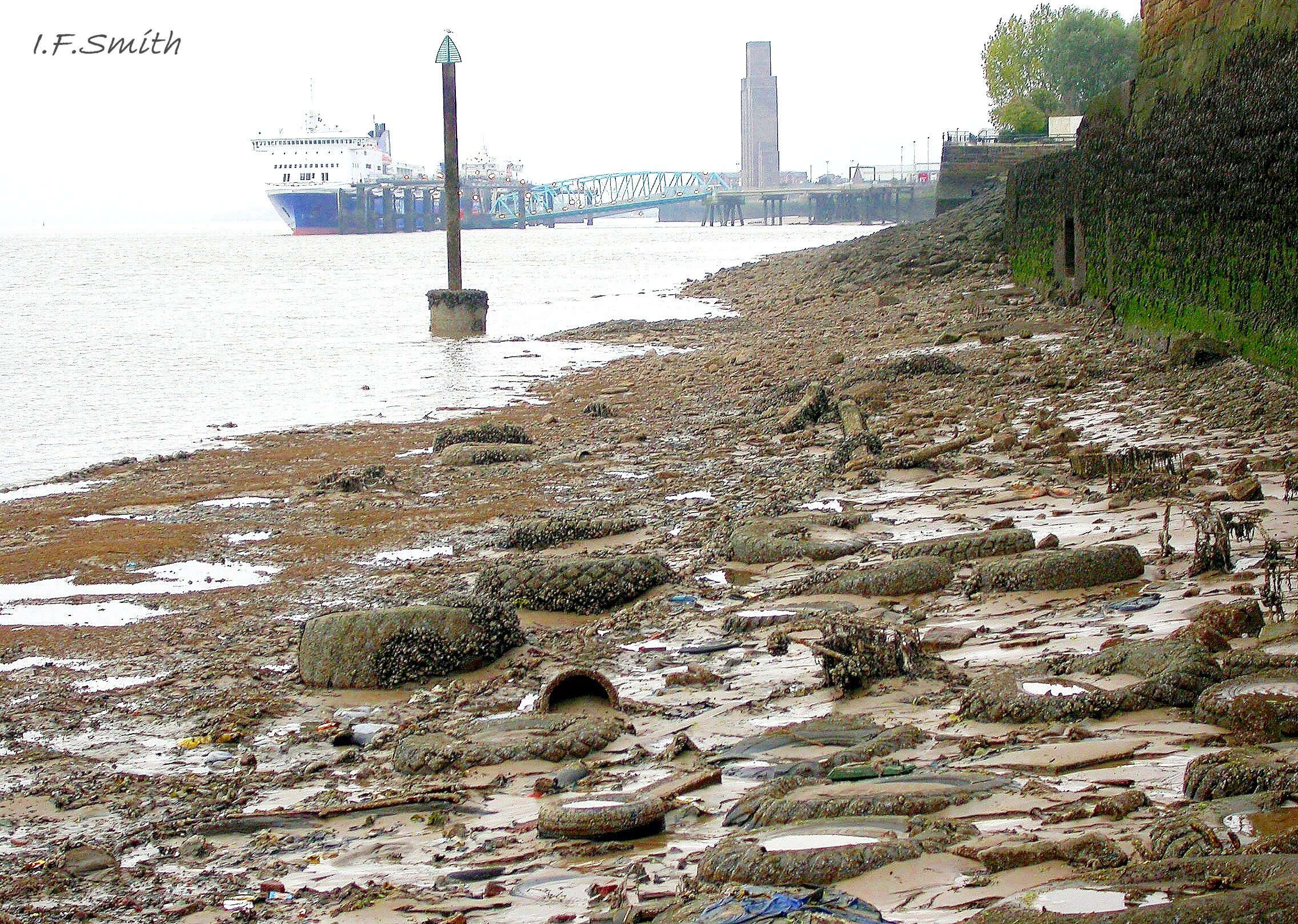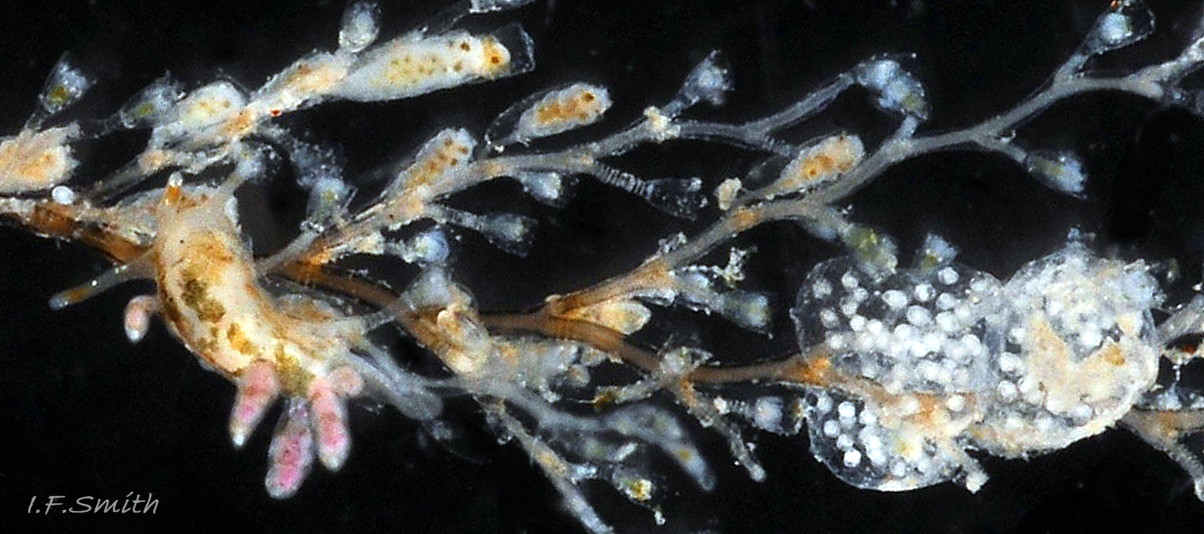Click image to enlarge with full caption. Main text below slider.
Eubranchus exiguus (Alder & Hancock, 1848)
PDF available at www.researchgate.net/publication/363701020_Eubranchus_exi…
Current taxonomy; World Register of Marine Species (WoRMS) www.marinespecies.org/aphia.php?p=taxdetails&id=139765
Synonyms: Eolis exigua Alder & Hancock, 1848.
GLOSSARY BELOW
Description
Frequently, the body of breeding adults is 5 or 6 mm long, sometimes growing to a usual maximum of 10 mm. It is translucent greyish white with many speckles and blotches of brown 01 Eubranchus exiguus or olive-green 02 Eubranchus exiguus surface pigment. There may be a few or many small opaque white spots 03 Eubranchus exiguus , but no extensive areas of white. A small, black, interior eye behind each rhinophore 04 Eubranchua exiguus is often only faintly visible 03 Eubranchus exiguus .
There are usually four or five, exceptionally seven, groups of cerata along each side of the body 04 Eubranchua exiguus . Each group usually has one large ceras, occasionally with one or two smaller ones. Some have very few cerata and a much exposed dorsum because of loss or lack of development 05 Eubranchus exiguus . The cerata are an urn-shape 04 Eubranchua exiguus which frequently pulsates expanding like a balloon 06 Eubranchus exiguus and then contracting. The ceratal surface is smooth; it can bulge but never has nodular tubercles (Thompson & Brown, 1984). The apex tapers abruptly from a broad diameter to a nipple-like point. The integument of the cerata is transparent, colourless revealing the buff 07 Eubranchus exiguus , peach 06 Eubranchus exiguus , pale brown or red 05 Eubranchus exiguus internal digestive gland. The gland is much narrower than an inflated ceras 06 Eubranchus exiguus . The ceratal integument has a subapical band of red, brown and/or gold and, immediately below it, a band of opaque white which tends to run into the upper band 08 Eubranchus exiguus . The two bands conceal the cnidosac within. The small extreme tip of the cerata is translucent whitish and occasionally reveals the top of the white cnidosac 09 Eubranchus exiguus , and there may be a translucent whitish zone below the opaque white zone above the top of the digestive gland 08 Eubranchus exiguus . Further down the cerata there are two or three brownish or olive encircling bands 09 Eubranchus exiguus which may be reduced to separated blotches 04 Eubranchua exiguus . The cerata often have a scattering of small white flecks 01 Eubranchus exiguus , which may predominate on specimens less than 2 mm long 07 Eubranchus exiguus .
The smooth, translucent whitish rhinophores have an opaque white subapical band and one 10 Eubranchus exiguus or two 02 Eubranchus exiguus brown bands.
The head has oral tentacles about half the length of the rhinophores with similar, but often less distinct, bands 10 Eubranchus exiguus . Ventrally the head has large outer lips which can protrude well in front of the foot 08 Eubranchus exiguus & 11 Eubranchus exiguus .
The narrow foot is slightly wider at the truncated anterior 08 Eubranchus exiguus & 11 Eubranchus exiguus , which has no propodial tentacles or lobes. The metapodium extends only a short distance beyond the posterior cerata 07 Eubranchus exiguus . The sole is translucent white, edged by the brown or olive of the body.
The hermaphrodite genital aperture is below the posterior of the first group of cerata on the right 03 Eubranchus exiguus & 12 Eubranchus exiguus , and sometimes has the needle-like penis protruding 13 Eubranchus exiguus . The white spheroid ovotestes are few in number and large relative to the body size. They may be visible through the sole 12 Eubranchus exiguus but pigment usually obscures the view laterally and dorsally.
Key identification features
Eubranchus exiguus
1) Very small, usually less than 10 mm long, frequently 4 – 6 mm.
2) Sparse urn shaped cerata 04 Eubranchua exiguus able to expand balloon-like 06 Eubranchus exiguus , surface lacks nodular tubercles.
3) Olive or brown blotches on body, no zigzag digestive gland 07 Eubranchus exiguus .
4) Probably common, but overlooked, all round Britain and Ireland; often present with T. tergipes. species.nbnatlas.org/species/NBNSYS0000175214
Similar species
Tergipes tergipes (Forsskål, 1775) 14 Eubranchus exiguus.
1) Very small, usual maximum 8 mm frequently less than 6 mm,.
2) Smooth slender cerata arranged singly along each side; their surfaces lack nodular tubercles.
3) Brown digestive gland zigzags between all cerata, except anterior one on right.
4) Common, but overlooked, all round Britain and Ireland; often present with E. exiguus. species.nbnatlas.org/species/NHMSYS0021056159
Capellinia doriae (Trinchese, 1874)
1) Small, maximum length 12 mm.
2) Up to seven rows of cerata each side; five or six, occasionally eight cerata per row, surface has two or three rings of white, little-globe tipped tubercles; ‘globetti bianchi’ (Trinchese, 1874) 15 Eubranchus exiguus. Small juveniles have single cerata and weak tubercles but may show truncated cones, ‘coni tronchi’, in cerata 16 Eubranchus exiguus.
3) Olive or brown blotches on body, no zigzag digestive gland 17 Eubranchus exiguus .
4) Mediterranean and Atlantic Europe with scattered records around Britain and Ireland. NBN UK map species.nbnatlas.org/species/NHMSYS0021324481
Eubranchus rupium (Møller, 1842) 18 Eubranchus exiguus
1) usually about 7 mm long, maximum about 10 mm.
2) Up to about twelve cerata, usually arranged singly, on each side. Cerata have a variable swelling near the mid-point 19 Eubranchus exiguus, but the surface lacks ‘globetti bianchi’ (white. little-globe tipped tubercles).
3) Small, orange-brown spots scattered over the body and cerata, with a distinct or faint, zigzag, green 18 Eubranchus exiguus , brown 20 Eubranchus exiguus or red 21 Eubranchus exiguus digestive gland between the cerata in the posterior half of the dorsum. In the anterior half, the digestive gland is fragmented and does not cross from side to side.
4) A northern species found in Scandinavia, Netherlands and north-east North America, with rare records in northern Britain and Ireland.
GBIF map www.gbif.org/species/4360230
Eubranchus vittatus> (Alder & Hancock, 1842)
1) Up to 29 mm long.
2) Up to 10 rows of smooth, slender cerata each side; about 10 cerata per row; their surfaces lack nodular tubercles 22 Eubranchus exiguus.
3) Olive or brown blotches on body, no zigzag digestive gland 23 Eubranchus exiguus .
4) Widespread on British coasts, except North Sea species.nbnatlas.org/species/NBNSYS0000175218#tab_mapView
E. cingulatus (Alder & Hancock, 1847, 24 Eubranchus exiguus ) was accepted as a valid species by Thompson & Brown (1984), but it is now regarded by WoRMS as a synonym of E. vittatus. Thompson and Brown (1984) wrote, “Records of this species are chaotic because of confusion with E. doriae. – – – Thompson & Brown (1976) and Schmekel and Portmann (1982) have all published illustrations of E. doriae incorrectly labelled as E. cingulatus”.
Habits and ecology
E. exiguus lives on the lower shore and sublittorally to 40 m. It is found on hydroids, especially Obelia dichotoma growing on stones and O. geniculata on Laminaria fronds, and on many other hydroids on piers, floating structures and ships. It favours shores with moderate wave exposure or shelter, including estuaries 25 Eubranchus exiguus , and salinity down to 6‰ in the outer Baltic (Swennen, 1961).
It is a simultaneous hermaphrodite. Ovotestes and penis may be developed by the time E. exiguus is 2 mm long 12 Eubranchus exiguus & 13 Eubranchus exiguus . Kidney-shape transparent spawn capsules 26 Eubranchus exiguus , each containing about 30 white ova, are laid from spring to late summer in Britain and Ireland. Spawn masses on hydroids are easier to detect and more numerous than adults, but difficult to distinguish from spawn of T. tergipes. Embryology and development are uncertain because of confusion with other species. It probably has a veliger stage and several generations each year (Miller, 1958).
Distribution and status
E. exiguus is recorded from the White Sea and Faeroe to the outer Baltic, western Europe and Mediterranean, and on North American Atlantic coasts www.gbif.org/species/2291727 . Densities of 200 /m² have been recorded in the Netherlands (Swennen, 1959). There are scattered records all round Britain and Ireland; it is probably common but overlooked as its small size requires searching of hydroids under magnification. UK map NBN species.nbnatlas.org/species/NBNSYS0000175214
Acknowledgements
For use of images I gratefully thank Glenn Biscop, Klaus Kevin Kristensen, Heine Jensen, Antoni Lopez-Arenas, Tamsyn Mann, Poul Rasmussen and Fabio Vitale. I thank Lucy Kay and Paul Brazier for specimens to photograph.
References and links
Alder, J. & Hancock, A. 1845-1855. A monograph of the British nudibranchiate mollusca. London, Ray Society. Family 3 Plate 37 www.biodiversitylibrary.org/item/131598#page/436/mode/1up
Gould, A. A. 1870. Report on the Invertebrata of Massachusetts, published agreeably to an order of the legislature. Second edition, comprising the Mollusca. Boston, Wright & Binney. [Eubranchus rupium as Aeolis despecta p. 248] at www.biodiversitylibrary.org/item/22325#page/262/mode/1up and Plate XVI figs. 222-225 at www.biodiversitylibrary.org/item/22325#page/541/mode/1up
Lopez-Arenas, A. Eubranchus doriae [in] Bitxos del Mediterrani [Accessed 17 September 2022]. www.tonitofa.com/arxius/454
McDonald, G. Eubranchus rupium (Møller, 1842) Intertidal Invertebrates of the Monterey Bay Area, California. [Accessed 10 September 2022]
people.ucsc.edu/~mcduck/DreamWeaver/Mollusca/Nudibranchs/…
Miller, M.C. 1958. Studies on the nudibranchiate Mollusca of the Isle of Man. PhD Thesis, University of Liverpool.
Møller, H. P. C. (1842). Index Molluscorum Groenlandiae. Naturhistorisk Tidsskrift. 4: 76-97 [Copenhagen] [ Eubranchus rupium as Tergipes rupium p. 78]
www.biodiversitylibrary.org/page/2322910#page/86/mode/1up
Nunn, J. Eubranchus doriae Northern Ireland Priority Species. [Accessed 10 September 2022]. www.habitas.org.uk/priority/species.asp?item=639
Rudman, W.B., 2003 Eubranchus rupium (Møller, 1842). [In] Sea Slug Forum. Australian Museum, Sydney. www.seaslugforum.net/find/eubrrupi
Swennen, C. 1959. The Netherlands coastal waters as an environment for Nudibranchia. Basteria 23: 56-62.
Swennen, C. 1961. Data of distribution, reproduction and ecology of the nudibranchiate molluscs occurring in the Netherlands. Netherlands J. Sea Res. 1: 191-240.
Thompson, T.E. & Brown, G.H. 1976. British opisthobranch molluscs. London, Linnean Society and Academic Press.
Thompson, T.E. & Brown, G.H. 1984. Biology of opisthobranch molluscs 2. London, Ray Society.
Trinchese, S. 1874. Descrizioni di alcuni nuovi Eolididae del porto di Genova. Memorie della Reale Accademia delle Scienze dell’ Istituto di Bologna. 3 (4): 197-203., biodiversitylibrary.org/page/39043163 Capellinia doriae
description on p. 202.
Vitale, F. Capellinia doriae Trinchese, 1874, [in] Heterobranchia della penisola del Salento [Accessed 17 September, 2022]
www.salentosommerso.it/pp_nudibranchia/Capellinia%20doria…
Glossary
cerata = (sing. ceras) lobes on dorsum of Fionoidea and some other seaslugs.
cnidocytes = explosive stinging cells of Cnidaria (hydroids, sea anemones, jelly fish).
cnidosac = storage capsule at tips of cerata of Fionoidea for ingested unexploded cnidocytes.
digestive gland = organ which acts like liver and pancreas in mammals to absorb food.
Fionoidea = superfamily of cerata-bearing sea slugs.
LWST = low water spring tide; two periods of a few days each month when tide falls lowest.
metapodium = hind portion of the foot. (adj. metapodial).
ovotestis = (pl. ovotestes) hermaphrodite organ serving as both ovary and testis.
propodium = anterior portion of gastropod foot. (adj. propodial).
rhinophores = chemo-receptor tentacles on top of head of nudibranch.
veliger = shelled larva of marine gastropod which moves by action of cilia on a velum (bilobed flap). Stage may be passed in plankton or within liquid-filled egg-capsule.
